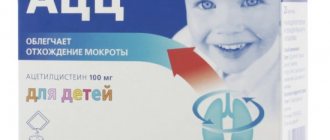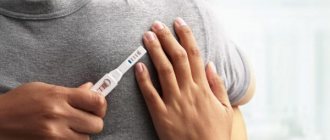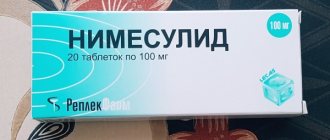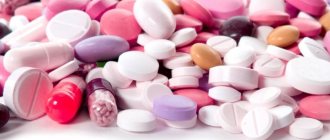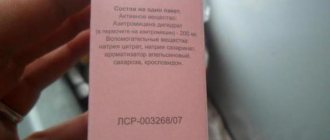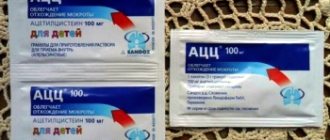Basic pharmacological properties of the drug
This drug is a combination drug that immediately affects several main mechanisms of the development of colds. Paracetamol is a non-steroidal pain reliever with a mild anti-inflammatory effect. It is also worth noting that this component only reduces the “feverish” temperature. Paracetamol is quickly absorbed by the tissues of the digestive system; at normal doses, it does not affect the mucous membrane of the stomach and intestines, and does not affect the water-salt balance.
Phenylephrine hydrochloride causes constriction of small vessels, thereby reducing swelling of the mucous membrane of the nasal passages, facilitating breathing and reducing the severity of exudative phenomena.
Pheniramine maleate, in turn, relieves spasm of smooth muscles (including bronchospasm), reduces swelling, and has mild sedative properties.
Caffeine stimulates the activity of the central nervous system, eliminates drowsiness, increases performance, and also enhances the analgesic effect of paracetamol.
Overdose
Most often, symptoms of exceeding the maximum permitted dose of paracetamol appear, since other components are contained in the drug in smaller proportions.
Signs such as nausea, vomiting, abdominal pain, increased sweating, and general malaise appear. Such symptoms may appear on the first day after an overdose.
If you suspect an overdose, you must:
- seek medical help;
- in the first 2 hours, rinse the stomach;
- no later than 6 hours - give the child activated carbon.
Also, symptoms of liver failure may appear within 72 hours, which requires immediate hospitalization and treatment in a hospital.
Instructions for use
Before use, the contents of one Rinzasip sachet are diluted in approximately a glass of water, ideally 200 mg. But if it is difficult for children to drink such a volume, then you can either reduce the amount of water slightly, or give the drink not immediately, but by dividing it into 2-3 servings. The water should be warm enough for the powder to completely dissolve, but not hot enough so as not to burn the oral mucosa.
As a rule, unless the doctor prescribes a different order of administration, children from 6 to 10 years old drink the drink twice a day, children over 10 and under 12 years old - three times a day. Over the age of 12 years, up to four sachets can be given per day.
In this case, you can use one of the traditional methods to reduce the temperature, for example, apply ice or do cold rubbing. If your body temperature is critically high, you should seek emergency medical help.
The total recommended duration of treatment is 5 days.
How much and how to give
Rinza Kids is very easy to use for treating children. To prepare a solution for internal use, pour the contents of one sachet into a container with pre-boiled and slightly cooled water (volume 200 ml).
Dosing Features:
- children from 6 to 10 years old, 1 sachet twice a day;
- children from 10 to 12 years old - one sachet three times a day;
- children over 12 years old – one sachet up to 4 times a day.
The interval between each dose of the drug should exceed 4-6 hours. It is forbidden to store the prepared solution; it must be used immediately. The course of therapy cannot be continued for more than five days in a row.
After 15 years of age, children can take adult dosages of the drug. Tablets are taken one at a time up to 5 times a day, powders up to 4 times a day. It is imperative to maintain a four-hour interval between each dose.
Instructions for use
The use of this pharmaceutical product usually does not cause difficulties. You need to pour the contents of one dose of the drug into a glass of pre-boiled hot water and stir the liquid thoroughly. You need to drink the medicine immediately after preparing it. The prepared solution cannot be stored.
If such a desire arises, you can add a little honey or sugar to the contents of the sachet in the water.
Dosing Features:
- children over 15 years of age and adult patients can drink from 3 to 4 sachets per day with a time interval of 6 hours;
- the course of therapy can last from three to five days.
It is very important to read the instructions, in particular the conditions that reflect the specifics of using the medication. https://www.youtube.com/embed/fVzjpeuauDQ
https://youtube.com/watch?v=fVzjpeuauDQ
Special conditions:
- while using Rinzasip, you should not drink alcohol, take antidepressants or other drugs that have a hypnotic effect;
- It is prohibited to take other products containing paracetamol;
- if it is necessary to use other pharmaceutical drugs simultaneously, you should obtain specialist advice about their interactions in advance;
- if the patient’s condition does not improve within 3-5 days from the start of drug therapy, you should consult a doctor;
- the drug has a slight effect on the reaction rate, so you should avoid working with complex mechanisms, as well as driving vehicles.
Despite the fact that you can purchase the product without presenting a medical prescription, if you have any doubts about the possibility of using this medicine, you should consult your doctor.
It is very important to strictly follow the dosage regimen indicated in the instructions, otherwise the likelihood of an overdose increases, which is especially dangerous due to the presence of paracetamol in Rinzasip. Overdose symptom:
Overdose symptom:
- nausea;
- dyspeptic disorders;
- epigastric pain;
- loss of appetite;
- liver dysfunction;
- paleness of the skin.
To alleviate the patient’s condition, you should immediately rinse his stomach, give him sorbents to drink, and seek medical help. In a hospital setting, a person can be given paracetamol antidotes - acetylcysteine, methionine. In addition, to improve his well-being, symptomatic therapy is indicated.
Indications and contraindications
The use of Rinzasip is indicated for people suffering from influenza, ARVI, febrile conditions caused by the development of other infectious pathologies, as well as after orthopedic operations.
The medicine is used to eliminate the following cold symptoms:
- headaches, muscle, joint pain;
- nasal congestion;
- sneezing;
- cough;
- increased body temperature;
- general weakness;
- discharge from the nasal cavity.
Despite the high effectiveness of the drug, not all patients can use it.
Contraindications to the use of Rinzasip:
- pregnancy period;
- breastfeeding time;
- child's age under 15 years;
- simultaneous use of other medications related to monoamine oxidase inhibitors, tricyclic antidepressants, beta-blockers;
- personal intolerance to the components of the drug.
In addition, there is a list of indications when you can take the powder, but only after receiving doctor’s approval:
- atherosclerosis;
- increased blood pressure readings;
- diabetes;
- thyrotoxicosis;
- insufficiency of production of a number of enzymes;
- bronchial asthma;
- systemic blood pathologies;
- chronic pulmonary obstruction;
- liver diseases.
Indications
This medicine should be used in case of inflammatory pathologies of the mucous membranes of the upper respiratory tract, diseases of the nose, throat, and lungs.
We recommend reading: IDRINK: instructions, reviews, analogues, price in pharmacies
The drug effectively relieves a person from the following cold symptoms:
- headache;
- increased body temperature;
- nasal congestion;
- sneezing, coughing;
- lacrimation;
- general weakness;
- muscle and joint pain.
Rinza is used for flu and colds, prevention and treatment of other viral pathologies.
Drug interactions
When used simultaneously, Rinzasip enhances the effects of sedatives, MAO inhibitors and ethanol.
The risk of developing dry mouth, urinary retention and constipation increases when used together with antidepressants, antiparkinsonian drugs, antipsychotic drugs, phenothiazine derivatives.
When Rinzasip is used simultaneously with glucocorticosteroids, the risk of glaucoma increases.
Paracetamol, which is part of the drug, reduces the effectiveness of concomitantly used diuretics.
The adrenomimetic effect of phenylephrine is enhanced by tricyclic antidepressants; when prescribed with halothane, the risk of ventricular arrhythmia increases.
The simultaneous use of Rinzasip with guanethidine leads to a decrease in the antihypertensive effect of the latter, while the alpha-adrenergic stimulating effect of phenylephrine is enhanced.
The risk of hepatotoxicity of paracetamol increases when Rinzasip is used together with diphenine, carbamazepine, barbiturates, rifampicin and other inducers of microsomal liver enzymes.
Rinza
Rinza (paracetamol + phenylephrine + pheniramine + vitamin C + caffeine) is a combination medicine for the treatment of colds and flu. These diseases have a whole complex of characteristic symptoms, which may often be beyond the power of a single drug to relieve. In such cases, combination medications come to the rescue, a prime example of which is Rinza. Each active component of the drug affects a specific symptom of the disease, and together, thanks to the combination of pharmacological properties, they provide rapid elimination of key symptoms. Paracetamol is an effective means of mitigating or completely relieving pain typical of influenza and acute respiratory infections (headache, muscle pain, pain when swallowing). At elevated temperatures it exhibits the so-called “central” antipyretic effect due to the property of paracetamol to block the synthesis of prostaglandins. The severity of the action of paracetamol is determined by its dose. According to WHO, this substance is most effective for colds and flu in a dose of 500-1000 mg. Rinza contains 500 mg of paracetamol. Phenylephrine activates alpha-adrenergic receptors of the vascular wall, thereby providing pronounced vasoconstriction and, as a result, resorption of edema and elimination of hyperemia of the mucous membranes of the upper respiratory tract and sinuses. Pheniramine inactivates histamine receptors, thereby promoting the resorption of edema, reducing the capacity of the walls of capillary vessels, and moderate vasoconstriction. Thanks to pheniramine, typical manifestations of allergies are eliminated: itching in the nasal cavity and oropharynx, swelling of the mucous membranes, rhinorrhea and increased mucus secretion. Vitamin C improves immune status, accelerates metabolism, acts as an antioxidant, is involved in hematopoiesis, and has its own anti-allergic and anti-inflammatory effects. Caffeine stimulates the central nervous system, improves mood, reduces fatigue, restores vitality, speeding up recovery, and increases performance.
Rinza is contraindicated in cases of severe atherosclerotic damage to the coronary arteries, severe hypertension, diabetes mellitus in advanced stages, individual intolerance to the components included in the drug, during pregnancy and lactation. In pediatrics, Rinza can only be used when the patient reaches 15 years of age. A single dose of the drug is 1 tablet. Frequency of application: 3-4 times a day. The duration of the medication course should not exceed 5 days. Possible undesirable side reactions: allergic manifestations, somnological disorders (delayed sleep), arterial hypertension, dyspeptic disorders, abdominal pain, changes in the blood picture (a consequence of the presence of paracetamol in the drug), narrowing of the lumen of the bronchi, disruption of the liver and kidneys. Rinza potentiates the effect of sedatives and ethanol-containing products. During a medication course using Rinza, it is necessary to avoid taking sleeping pills, benzodiazepine tranquilizers, alcoholic beverages, and other medications containing paracetamol to avoid overdose. Signs of the latter: pale skin, loss of appetite, nausea and/or vomiting, activation of liver transaminases, necrosis of liver tissue. If there are signs of paracetamol overdose, you should immediately seek medical help. Gastric lavage is prescribed, followed by the use of adsorbents, methionine and acetylcysteine. While taking Rinza, it is recommended to limit or exclude activities that require increased attention, concentration and reaction speed, incl. working on potentially dangerous production mechanisms and driving a car. When using Rinza together with other hepatotoxic drugs, the risk of liver damage increases due to the presence of paracetamol in the drug.
Side effects
Using the drug for a long time can provoke the development of negative manifestations from various body systems.
Side effects:
Before using the medicine, it is very important to study the instructions for the compatibility of other pharmaceuticals with Rinzasip. Drug interactions:
Drug interactions:
- enhancing the effect of ethanol, sedatives, monoamine oxidase inhibitors;
- increased risk of developing adverse reactions when using drugs against Parkinson's disease, antipsychotic compounds, antidepressants, phenothiazine derivatives;
- combination with glucocorticosteroids increases the risk of glaucoma;
- the use of Rinzasip and diuretics reduces the effectiveness of the latter;
- the hepatotoxic effect of paracetamol increases if a person simultaneously takes carbamazepine, rifampicin, barbiturates, diphenin;
- the antihypertensive effect of Guanethidine will be reduced;
- Guanethidine may increase the stimulant effect produced by phenylephrine hydrochloride;
- combined use of Halothane may provoke the development of ventricular arrhythmia;
- tricyclic antidepressants enhance the adrenomimetic effect of phenylephrine hydrochloride.
Detailed instructions
This medication should be used, if possible, in the first hours after the appearance of the corresponding signs of acute respiratory infections. According to the standard instructions of Rinzasip, the drug should be taken an hour and a half after eating. To prepare the solution, pour the powder from the sachet into a glass or cup and add water, stirring until completely dissolved. Only hot water can be used. The drink turns out to be very aromatic and pleasant to the taste. If desired, you can add a small amount of honey.
The maximum allowable amount of drugs per day is four sachets. If the symptoms of acute respiratory infections do not go away within 5 days, you must inform your doctor so that he can adjust the treatment methods. It is not recommended to take the medication for longer than the specified period. Self-administration of medications can negatively affect the general condition and lead to unwanted reactions.
In addition, to safely take the drug, you should familiarize yourself with the special instructions that relate to taking drugs:
First of all, you should give up alcohol for the period of treatment, since the components of the drug enhance the effects of ethanol on the body.
It is not recommended to simultaneously take this powder and similar drugs that contain paracetamol. This will help avoid overdose
If the patient is already taking any medications, he needs to inform his doctor. Thus, he will be able to select the most effective treatment methods, and the patient will be able to prevent unforeseen consequences of drug interactions.
The effect of drugs on the central nervous system can affect psychomotor reactions, therefore, those patients whose activities require the need to act in extreme conditions should take them with caution. The course of treatment lasts 3-5 days
In some cases it can be extended to 7 days. But only on the recommendation of a specialist. Since you can buy Rinzasip at any pharmacy without presenting a prescription, you need to be as careful as possible so as not to buy a counterfeit. If you have any doubts about the quality of the drug, it is better to consult your doctor.
Release forms and composition of the drug
The composition of the drug includes several components, each of which performs the functions assigned to it, eliminating one or another symptom.
Rinzasip with vitamin C is a powder packaged in packets for single doses. The powder is granules of two colors: orange and white. The medicine may have different tastes, depending on what flavor was added (blackcurrant, orange, lemon).
The pharmacological action, pharmacodynamics of Rinzasip, is provided by the following active ingredients:
- phenylephrine hydrochloride (10 mg);
- paracetamol (750 mg);
- pheniramine maleate (20 mg);
- caffeine (30 mg);
- sodium citrate (500 mg);
- for preparations with different tastes: citric acid (200 mg);
- sucrose;
- carmoisin dye.
There is only a powder form of release; the packaging is a cardboard pack containing from 5 to 100 sachets of powder.
The therapeutic effectiveness of the drug is achieved due to the action of its main components:
- Paracetamol: a substance belonging to the group of non-steroidal and anti-inflammatory drugs. Responsible for blocking cyclooxygenase, which prevents it from stimulating the production of prostaglandins (mediators of inflammation and pain) by the hypothalamus.
- Caffeine: a brain stimulant that increases productivity and improves mood.
- Phenylephrine hydrochloride: a vascular alpha receptor stimulant that causes vasoconstriction, resulting in decreased tissue swelling, decreased nasal mucus, and easier breathing.
- Pheniramine maleate: a histamine receptor blocker that helps reduce allergic manifestations that necessarily develop against the background of every acute respiratory viral infection.
Each of these substances is actively absorbed by the walls of the digestive tract, penetrating into the bloodstream. Metabolic processes of all active substances pass through the liver, after which active metabolites are released. They leave the body along with urine.
Some people believe that Rinzasip is a drug. This to me is completely erroneous; the drug does not contain substances that can have such a negative effect on the human body. Compliance with the rules of dosing of a pharmaceutical product does not in any way affect a person’s consciousness, only removing the catarrhal symptoms of a cold.
Operating principle
Rinza contains several active components in its composition, which explains such a wide spectrum of its action. The drug has an anti-inflammatory and analgesic effect, relieving a person of the symptoms of acute respiratory infections.
The therapeutic effect of the drug is achieved by several components at once:
- paracetamol belongs to the group of non-steroidal anti-inflammatory substances. It has the ability to block a special enzyme called cyclooxygenase, without which the conversion of arachidonic acid into prostaglandins does not occur. The latter are called mediators of pain and inflammation; when their amount in the body is minimal, a person experiences less discomfort. This effect leads to a physiological norm of increased body temperature, relieves pain and, to a small extent, reduces the severity of the inflammatory process;
- caffeine has the ability to stimulate central nervous system activity. improving brain function, causing slight stimulation and increasing tone. It relieves headaches and migraines;
- Phenylephrine hydrochloride stimulates the activity of alpha receptors located in the structure of the choroid plexus. Under its influence, vasoconstriction occurs, which leads to a decrease in swelling of the nasal passages, a decrease in the amount of mucus secreted and easier breathing;
- Pheniramine is an antihistamine; it does not allow the active release of histamine from special receptors. This leads to a decrease in the severity of the allergic reaction, which is manifested by nasal congestion and flow, and constant sneezing.
The children's form of Rinza is called Rinzasip, it additionally contains ascorbic acid. This component has the ability to strengthen the immune system, increase vascular permeability, bind free radicals, alleviating the condition of a sick person.
Each of the substances contained in the drug is absorbed (after oral administration) by the mucous membrane of the digestive tract, from where it penetrates into the systemic bloodstream. Metabolic processes of the drug take place in the liver, where metabolites are formed that do not differ in activity and are excreted outside the body along with urine.
Safe dosage
Adults are recommended to take 1 sachet up to four times a day, preferably a couple of hours after meals, at intervals of 4-6 hours. The duration of the course of therapy is no more than 5 days. The drug should be taken with a sufficient amount of liquid - a glass of water per sachet. Can be sweetened with sugar or honey.
Contraindications, overdose and side effects
Rinzasip is not prescribed to children under the age of 15 years, to patients suffering from diabetes mellitus, renal or hepatic insufficiency, coronary heart disease, or bronchial asthma.
In case of overdose, general pallor of the skin, nausea and vomiting, and liver failure are observed. You should do a gastric lavage as quickly as possible and allow activated charcoal to be taken orally. In severe cases, symptomatic therapy on an outpatient basis is necessary.
In addition, the following side effects may occur:
- tachycardia and heart failure;
- nausea, chest pain, dry mouth;
- dizziness, agitation, insomnia;
- skin rashes, itching, skin irritation;
- difficulty urinating, various types of anemia.
It is forbidden to take other paracetamol-containing drugs and alcohol at the same time as the medicine.
You should refrain from any activity associated with increased attention and quick reaction while taking the powder.
Analogs
If there is a need to replace Rinzasip, this issue should be approached with maximum responsibility. Analogues can be developed on identical components or differ in composition, but have a similar effect on the body.
The most effective substitutes:
- Fervex (280 rub.). Cold powder contains three main components: ascorbic acid, pheniramine, paracetamol. It is characterized by anti-inflammatory, antipyretic and analgesic properties.
Relieves swelling, affects pain centers, normalizes body temperature, which increases as a result of the activity of a viral infection. One package contains 8 sachets (5 g each) with granular powder.
- Solpadeine (from 170 to 195 rubles). The cost of the medicine depends on the dosage and form of release. Pharmacies offer several types of drugs: film-coated tablets and water-soluble (effervescent) tablets. The main components are paracetamol and caffeine. Reduces temperature, relieves pain syndromes. Under the influence of caffeine, the patient feels a surge of energy, drowsiness and fatigue disappear.
- Calpol (80 rubles). Release form: sugar syrup. The main substance is paracetamol. The suspension is characterized by antipyretic and analgesic effects. The advantage of the drug is that it can be taken by children from 3 months.
- AntiGrippin (from 100 rub.). It goes on sale in the form of a soluble powder. The mechanism of action is due to three main components: paracetamol, chlorphenamine maleate and ascorbic acid. This drug is characterized by analgesic and antipyretic effects. It also has a slight antiallergic effect.
It is better not to buy analogues on your own. An incorrectly selected medicine can only harm a weakened body.
Rinza's analogues
Analogs of the drug Rinza are Antigrippin, Gripout, Gripex Active, Coldrex, Paralen Extra, Antiflu, Theraflu, Fervex, Combigripp Hotsip, Rinzasip.
Figure 5 — Analogues of the drug Rinza
Rinza or Theraflu?
The effectiveness of Rinza is higher than that of Theraflu due to the large amount of paracetamol and caffeine in the composition. But this may cause side effects. Be careful!
Rinza or Coldact Flu Plus?
The effectiveness of both drugs is beyond doubt. Rinza and Coldact Flu Plus are used for the symptomatic treatment of colds. They practically do not differ in composition. The only difference is in the dosage of one or another component. Koldakt Flu Plus contains less paraetamol, but more phenylephrine, chlorpheniramine; no caffeine. The drugs are indeed prescribed for colds, ARVI, as an antipyretic, but it is worth considering that Coldact Flu Plus is more effective for swelling of the nasal mucosa, lacrimation and other allergy-like symptoms. But Rinza copes better with fever and pain.
Rinza or RiniCold?
These drugs are identical in effectiveness and composition. The only thing that distinguishes them is their price.
Rinza or AnviMax?
The effectiveness of Rinza and AnviMax is almost on the same level. Both drugs cope with the manifestation of colds, malaise, nasal congestion, headache, fever, etc. But they also have differences. Thus, Rinza has a more pronounced therapeutic effect than AnviMax. In general, both drugs begin to work quickly, leading to the desired result. But Rinza has fewer risks when used than AnviMax. Moreover, it is worth paying attention that the latter has a higher probability of negative reactions of the body to taking the drug (side effects, allergic reactions) than Rinza. Which imposes its own restrictions on reception. Although, judging by the instructions, the list of possible side effects for one drug and another is small.
Whatever drug you choose, pay close attention to your doctor’s recommendations and read the instructions for use. This will allow you not to harm your health and achieve a positive effect from taking the medicine.
Video: Rinza tablets - review
Directions for use: special instructions
The effect of a pharmaceutical product will be greater when it is taken not during food consumption. When the gastrointestinal tract is busy moving and digesting food, the absorption of the medication will not occur at the proper speed and quality.
Therefore, the medicine should be taken according to the doctor’s recommendations or the requirements specified in the instructions for the drug. The instructions indicate that Rinza contains substances that can impair the health of the gastric mucosa, so you should drink tablets or take powder no earlier than half an hour after your next meal.
When planning to dilute Rinza powder, at what age can this medicine be given to children, you need to find out in advance. The manufacturer recommends giving the drug called Rinza only to adolescents over the age of 15 years. The medicine, called Rinzasip for children (kids), is used in children from the age of six, it has a pleasant raspberry taste and aroma, in addition, it is additionally enriched with ascorbic acid, which has a beneficial effect on strengthening the immune system.
Before you start using any medicine, you should carefully read the instructions
Each annotation contains important requirements that must be read and taken into account
Special instructions:
- the period of therapy using Rinza imposes a ban on the consumption of alcoholic beverages, taking antidepressants, as well as medications that have a hypnotic effect;
- It is prohibited to simultaneously take medications containing paracetamol, as well as other drugs classified as non-steroidal anti-inflammatory substances;
- if it is necessary to simultaneously use other pharmaceuticals, you should obtain additional consultation from a specialist to find out the specifics of their interaction;
- when, after three to five days of taking Rinza, the patient’s condition does not improve, such therapy should be stopped and immediately seek medical help;
- Taking the drug can change the reaction rate, so during the period of treatment you should stop driving vehicles and working with complex mechanisms.
Features of using the product
When treating with Rinzasip, it is recommended to avoid drinking alcoholic beverages, sedatives and sleeping pills. It is also prohibited to use other medications containing paracetamol for treatment purposes.
The doctor is obliged to tell the patient that treatment should not be delayed for more than 5 days. If there is no effect, you should visit the specialist again to prescribe other remedies.
When treated with the drug, an adult should be careful about driving vehicles and engaging in hazardous activities that may require a high degree of concentration and attention.
For children, it is prohibited to take Rinzasip powder simultaneously with other paracetamol-based drugs. During treatment, it is important to monitor the functioning of the kidneys and liver. Compositions containing paracetamol can distort test results regarding the concentration of uric acid and glucose in the blood. If there is no effect from the drug after 3 days, you should urgently visit a doctor.
Negative reactions of the body
It is worth remembering that the drug is not absolutely safe. Most often, negative reactions manifest themselves in the form of allergic reactions (rashes) on the skin. A small rash on the body may be accompanied by burning or itching.
Also among the negative effects are possible:
- gastrointestinal disorders;
- dizziness, headaches, insomnia, increased intraocular or blood pressure;
- increased heart rate;
- anemia;
- broncho-obstructive syndrome;
- kidney failure;
- urinary retention.
If a side effect occurs, the medication should be stopped. Too long use of drugs or a single dose of a large dose can provoke an overdose. This phenomenon is accompanied by: attacks of nausea, blanching of the skin, vomiting and complete/partial loss of appetite.
Therapeutic measures include gastric lavage and the use of enterosorbents. To prevent complications of the condition, at the first symptoms of an overdose, you should contact your doctor.
Reviews of Rinzasip for children
Parents who have used the drug to treat children leave mostly positive reviews about Rinzasip for children. They note that when taking the drug, unpleasant cold symptoms are effectively eliminated: headache, rhinorrhea, fever, nasal congestion. The effect of the drug develops quickly. The prepared solution has a raspberry taste, which, however, not all children like. The powder is relatively inexpensive.
Among the disadvantages, they indicate the content of dye in the composition, the presence of a large list of contraindications and possible side effects. In isolated cases, there are complaints about the lack of effect from taking Rinzasip for children.
Composition and release form
The main components of the drug are paracematol and caffeine (see caffeine sodium benzoate for more details, use and instructions) - 750 and 30 mg, respectively. Other substances used include pheniramine maleate, phenylephrine hydrochloride, citric acid, sunset yellow, orange or currant flavor, sodium citrate and sucrose.
The medicine is available in powder form. The powder is dosed in 5 g portioned sachets, has an orange color and a characteristic aroma of citrus or black currant. When combined with water, it forms a fine suspension of the appropriate taste.
Rinzasip can be purchased either in individual bags or in packs of 10, 15, 20, 50 or 100 pieces.
Side effects
When using Rinzasip, side effects may develop:
- Cardiovascular system: increased blood pressure, tachycardia;
- Central nervous system: increased intraocular pressure, sleep disturbances, dizziness, mydriasis, increased excitability, accommodation paresis;
- Urinary system: nephrotoxic effect (papillary necrosis), urinary retention;
- Hematopoietic system: thrombocytopenia, anemia, agranulocytosis, hemolytic or aplastic anemia, pancytopenia, methemoglobinemia;
- Digestive system: hepatotoxic effect, epigastric pain, nausea, dry mouth;
- Allergic reactions: angioedema, skin rash, urticaria, itching;
- Other: broncho-obstructive syndrome.
Overdose symptoms associated with the effects of paracetamol usually occur when taking Rinzasip in a dose corresponding to 10-15 g of paracetamol. They are expressed in the form of anorexia, vomiting, pallor of the skin, nausea, hepatonecrosis, increased activity of liver transaminases, liver failure (increased prothrombin time).
To treat an overdose, gastric lavage, ingestion of activated carbon, and symptomatic treatment are indicated.
Tablets or syrup
Rinza, used for patients from the age of fifteen, comes in tablet form. In addition, children in this age category can consume Rinzasip powder. And children after 6 years old can use a powder called Rinzasip Kids.
How many tablets can a child take per day? Experts do not recommend using adult dosages of medications to treat children under 15 years of age. Rinza tablets cannot be divided into two or four parts, because the concentration of active ingredients in this case may be uneven. Such actions can provoke the development of overdose symptoms and significantly worsen the person’s condition.
The use of Rinzasip Kids powder for children under 6 years of age is prohibited. For them, the dosage of paracetamol may be too high, which can seriously affect their well-being, causing a dangerous overdose.
Special children's syrups (for example, Nurofen, Panadol) should be used to treat children under 6 years of age, for which there is a special dosing system based on the weight and age characteristics of the patient.
Contraindications
When treating colds with Rinzasip, the following is prohibited:
- simultaneously use sedatives and antidepressants, adrenergic blockers;
- taking other drugs with the same active ingredients.
The powder is also not recommended during pregnancy and lactation, in case of hypersensitivity to the components of the drug. During pregnancy and lactation, the drug can be replaced with a homeopathic remedy selected by the attending physician.
Doctors prescribe Rinzasip powder with caution to adults with atherosclerotic lesions of the coronary arteries, with a tendency to increase blood pressure, with thyrotoxicosis, diabetes mellitus, blood pathologies, and with liver or kidney failure.
Children should not take Rinzasip in the following situations:
- hypersensitivity to paracetamol and other active ingredients of the drug;
- when using other products with the same active ingredients;
- with serious disorders of the liver and kidneys;
- for blood pathologies;
- under the age of 6 years.
General information about the drug
Cold powder is characterized by thermoregulatory, analgesic, vasoconstrictor and antihistamine effects. It quickly and effectively relieves the symptoms of ARVI, helps to increase the tone of the vascular walls. Since the combination drug contains several main components, it has a wider spectrum of action.
Drug group, INN, scope of application
The drug is a representative of a pharmacological group consisting of medications intended for the symptomatic elimination of signs of colds and ARV infections. Manufacturers used caffeine, paracetamol, phenylephrine hydrochloride and pheniramine maleate as basic active ingredients. These components determine the mechanism of action of the cold powder.
Compound
The effectiveness of the powder is explained by its combined composition. The mechanism of action of the drug is provided by 4 components at once:
- Caffeine (30 mg). Helps improve performance, stimulates the active functioning of the central nervous system.
- Paracetamol (750 mg). An analgesic with a pain-relieving effect. Relieves hyperthermia, eliminates aches in joints and muscles during the development of viral diseases.
- Phenylephrine hydrochloride (10 mg) is an alpha adrenergic agonist. Eliminates nasal swelling, normalizes blood pressure. With prolonged use, the body gets used to the substance, so dosage adjustment may be necessary.
- Pheniramine maleate (20 mg). The substance helps block H1 histamine receptors. Eliminates bronchospasms. Has a mild sedative effect.
A list of additional components was used in the production process: sodium citrate, citric acid, sucrose, dyes and flavorings.
Pharmaco-properties
The main advantage of the drug is that it has a complex antipyretic and analgesic effect:
- Paracetamol temporarily reduces the activity of the thermoregulatory and pain centers.
- Phenylephrine relieves hyperemia and swelling of the mucous membranes, which allows you to clear the paranasal sinuses and restore normal breathing.
- Under the influence of caffeine, the overall tone of the body increases. The patient feels a surge of strength.
- Also, the medication slows down the intensity of the process of mucus secretion in the nasopharynx/bronchial tubes.
The substances contained in the drug do not have a negative effect on the gastrointestinal tract. Taking the medicine does not lead to disruption of water and electrolyte balance.
Absorption of substances occurs in the intestines. They are characterized by a fairly high degree of binding to plasma proteins. After 40-60 minutes, the peak amount of components in the plasma is recorded. Excretion from the body is carried out through the kidneys (with urine).
pharmachologic effect
A drug to eliminate the symptoms of acute respiratory infections and colds.
Combined drug.
Paracetamol has an analgesic and antipyretic effect. Reduces the pain syndrome observed during colds - sore throat, headache, muscle and joint pain, reduces high temperature.
Phenylephrine is an alpha1-adrenergic agonist. It has a vasoconstrictor effect, reduces swelling and hyperemia of the mucous membranes of the upper respiratory tract and paranasal sinuses.
Chlorphenamine is a blocker of histamine H1 receptors, has an antiallergic effect, reduces swelling and hyperemia of the mucous membranes of the nasal cavity, nasopharynx and paranasal sinuses, eliminates itching in the eyes and nose, and reduces exudative manifestations.
Caffeine has a stimulating effect on the central nervous system, which leads to a decrease in fatigue and drowsiness, and an increase in mental and physical performance.
